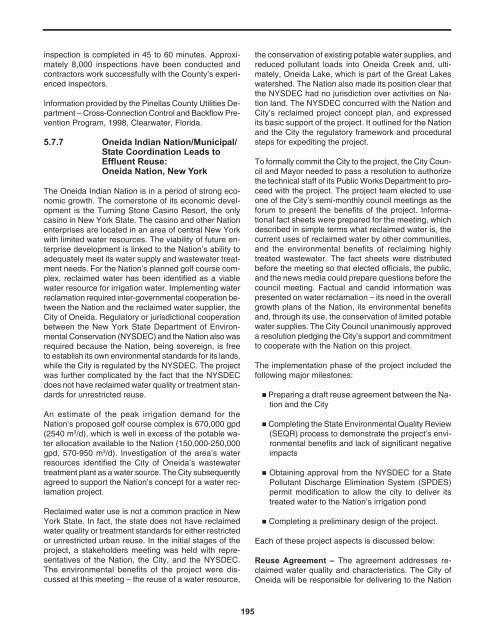o_19f3m1n7k170b14e9u0oqipgu4a.pdf
You also want an ePaper? Increase the reach of your titles
YUMPU automatically turns print PDFs into web optimized ePapers that Google loves.
inspection is completed in 45 to 60 minutes. Approximately<br />
8,000 inspections have been conducted and<br />
contractors work successfully with the County’s experienced<br />
inspectors.<br />
Information provided by the Pinellas County Utilities Department<br />
– Cross-Connection Control and Backflow Prevention<br />
Program, 1998, Clearwater, Florida.<br />
5.7.7 Oneida Indian Nation/Municipal/<br />
State Coordination Leads to<br />
Effluent Reuse:<br />
Oneida Nation, New York<br />
The Oneida Indian Nation is in a period of strong economic<br />
growth. The cornerstone of its economic development<br />
is the Turning Stone Casino Resort, the only<br />
casino in New York State. The casino and other Nation<br />
enterprises are located in an area of central New York<br />
with limited water resources. The viability of future enterprise<br />
development is linked to the Nation’s ability to<br />
adequately meet its water supply and wastewater treatment<br />
needs. For the Nation’s planned golf course complex,<br />
reclaimed water has been identified as a viable<br />
water resource for irrigation water. Implementing water<br />
reclamation required inter-governmental cooperation between<br />
the Nation and the reclaimed water supplier, the<br />
City of Oneida. Regulatory or jurisdictional cooperation<br />
between the New York State Department of Environmental<br />
Conservation (NYSDEC) and the Nation also was<br />
required because the Nation, being sovereign, is free<br />
to establish its own environmental standards for its lands,<br />
while the City is regulated by the NYSDEC. The project<br />
was further complicated by the fact that the NYSDEC<br />
does not have reclaimed water quality or treatment standards<br />
for unrestricted reuse.<br />
An estimate of the peak irrigation demand for the<br />
Nation’s proposed golf course complex is 670,000 gpd<br />
(2540 m 3 /d), which is well in excess of the potable water<br />
allocation available to the Nation (150,000-250,000<br />
gpd, 570-950 m 3 /d). Investigation of the area’s water<br />
resources identified the City of Oneida’s wastewater<br />
treatment plant as a water source. The City subsequently<br />
agreed to support the Nation’s concept for a water reclamation<br />
project.<br />
Reclaimed water use is not a common practice in New<br />
York State. In fact, the state does not have reclaimed<br />
water quality or treatment standards for either restricted<br />
or unrestricted urban reuse. In the initial stages of the<br />
project, a stakeholders meeting was held with representatives<br />
of the Nation, the City, and the NYSDEC.<br />
The environmental benefits of the project were discussed<br />
at this meeting – the reuse of a water resource,<br />
the conservation of existing potable water supplies, and<br />
reduced pollutant loads into Oneida Creek and, ultimately,<br />
Oneida Lake, which is part of the Great Lakes<br />
watershed. The Nation also made its position clear that<br />
the NYSDEC had no jurisdiction over activities on Nation<br />
land. The NYSDEC concurred with the Nation and<br />
City’s reclaimed project concept plan, and expressed<br />
its basic support of the project. It outlined for the Nation<br />
and the City the regulatory framework and procedural<br />
steps for expediting the project.<br />
To formally commit the City to the project, the City Council<br />
and Mayor needed to pass a resolution to authorize<br />
the technical staff of its Public Works Department to proceed<br />
with the project. The project team elected to use<br />
one of the City’s semi-monthly council meetings as the<br />
forum to present the benefits of the project. Informational<br />
fact sheets were prepared for the meeting, which<br />
described in simple terms what reclaimed water is, the<br />
current uses of reclaimed water by other communities,<br />
and the environmental benefits of reclaiming highly<br />
treated wastewater. The fact sheets were distributed<br />
before the meeting so that elected officials, the public,<br />
and the news media could prepare questions before the<br />
council meeting. Factual and candid information was<br />
presented on water reclamation – its need in the overall<br />
growth plans of the Nation, its environmental benefits<br />
and, through its use, the conservation of limited potable<br />
water supplies. The City Council unanimously approved<br />
a resolution pledging the City’s support and commitment<br />
to cooperate with the Nation on this project.<br />
The implementation phase of the project included the<br />
following major milestones:<br />
• Preparing a draft reuse agreement between the Nation<br />
and the City<br />
• Completing the State Environmental Quality Review<br />
(SEQR) process to demonstrate the project’s environmental<br />
benefits and lack of significant negative<br />
impacts<br />
• Obtaining approval from the NYSDEC for a State<br />
Pollutant Discharge Elimination System (SPDES)<br />
permit modification to allow the city to deliver its<br />
treated water to the Nation’s irrigation pond<br />
• Completing a preliminary design of the project.<br />
Each of these project aspects is discussed below:<br />
Reuse Agreement – The agreement addresses reclaimed<br />
water quality and characteristics. The City of<br />
Oneida will be responsible for delivering to the Nation<br />
195



